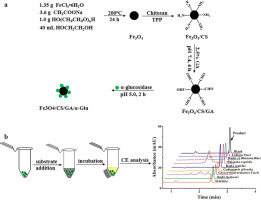 | Abstract: As the close correlation between a-glucosidase inhibitors and the treatment of diabetes, in combination with capillary electrophoresis (CE), a method was developed to screen a-glucosidase inhibitors from traditional Chinese medicines (TCMs) by immobilizing a-glucosidase on magnetic nanoparticles. Such a magnetic immobilization would be beneficial for enzyme reusability, stability and separation. In this work, Fe3O4 nanoparticles were synthesized by solvothermal method. And the prepared nanoparticles were characterized by transmission electron microscopy (TEM), Fourier transform infrared (FT-IR) spectroscopy, X-ray diffraction (XRD), size and zeta potential analysis. With the modification of chitosan (CS) and glutaraldehyde (GA), alpha-glucosidase was successfully immobilized on the magnetic nanoparticles. The pH and temperature endurance, storage stability and reusability of the immobilized a-glucosidase were studied and compared with those of the free one. With the magnetic immobilized a-glucosidase, the Michaelis-Menten constant (Km) was calculated to be 0.85 mM, and the inhibition constant (K-i) and half-maximal inhibitory concentration (IC50) for acarbose were determined to be 7.37 and 13.69 mu M, respectively. Finally, the developed method was applied to screen alpha-glucosidase inhibitors from 18 TCMs. KeyWords Plus: RUGOSA LIPASE IMMOBILIZATION; CHITOSAN NANOPARTICLES; DRUG-DELIVERY; MICROREACTOR; OXIDASE; FACILE Published in TALANTA,164 548-555; 10.1016/j.talanta.2016.12.028 MAR 1 2017 |

